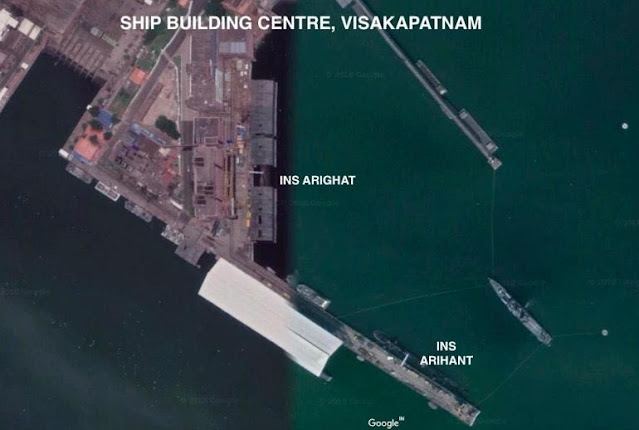Gessler posted details here on December 30, 2021 concerning the reported November 2021 launch of the Arihant class SSBN S4. Gessler reports:
Launch of S4 is "a pretty significant development in the region:
India seems to have launched the 3rd nuclear boat (hull S4) of Arihant-class [in November 2021]:
https://twitter.com/CSBiggers/status/1476048094580117509
-----
I don't have a Janes' subscription so can't delve deeper into the details contained therein. However, commercial satellite imagery [above (see earlier imagery of the S4 shed above provided by Ghalib Kabir in August 2021 and November 2018)] obtained by open-source intelligence (OSINT) contributors on Twitter seems to validate the notion that the 3rd & 4th boats of the class will indeed be bigger than the first two (also corroborating nuclear expert Hans M. Kristensen's extrapolation based on size of the submarine shed [seen lower center] deployed a few months ago, which I've talked about previously on here): https://twitter.com/deadtrap777/status/1476204012353458177
Further details are still awaited but if the earlier literature about the "Arihant Stretch" class holds true, the 3rd & 4th boats could indeed have 8 x missile silos, for either 8 x long-range SLBMs (like K4 or K5), or up to 24 x medium-range SLBMs (like K15) with a triple-pack in each silo - or any combination thereof, depending on requirements.
In the late 2030s when these boats might take one an SSGN role, it could mean up to 40-48 land-attack cruise missiles on the "Stretch" boats like I previously speculated on here.
PETE COMMENT AND BACKGROUND ON ARIHANT CLASS REACTORS
Note that S4 is the 3rd Arihant class SSBN launched:
- S1 was a land based prototype reactor designed for the 4 Arihant class SSBNs known as S2, S3, S4 and S4*.
- The first 2 Arihants, already launched are S2 (INS Arihant) and S3 (INS Arighat), each believed to displace 6,000 tonnes and have 4 full sized SLBM silos. S2 and S3 are powered by a reactor rated at 83MWt (where t = thermal). Using a rule of 1/6 to convert MWt to MWe this implies available electrical power of 13.8MWe for the submarine's propulsion and non-propulsion "hotel load" electrical needs. Hotel load includes life sustaining electrical uses such a air and drinking water regeneration as well as cooling air conditioning for the crew and to cool electronic equipment.
The final two Arihant class SSBNs, S4 and S4*, are believed to displace 7,000 tonnes, have 8 full sized SLBM silos and possibly use a reactor uprated to 90MWt = 15MWe.
It is unknown whether some or all of the Arihants use a pumpjet (developed by India's DRDO) instead of a propeller.
In the New Year I (Pete) will present Gessler's second December 30 comment. I'll also comment more extensively on the implications of S4's launch and on the broader Arihant class.
Happy New Year
Pete



